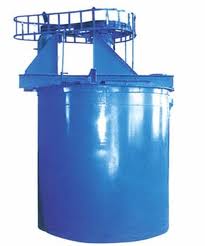-
Sand Making Crusher
- PCL-Vertical Shaft Impact Crusher
- SBM Hydraulic VSI Crusher
- VSI5X Series Impact Crusher

Attrition Scrubber

Propellers
The Helix propeller is very effective in providing the vertical and radical forces for maximum scrubbing. Two six-bladed propellers are mounted on each shaft to provide opposed pumping forces. One propeller has slightly greater blade pitch than the other, which causes the pulp to be pumped from cell to cell.
Flow alternates introduction to the cells by way of over and under openings in the baffles between the succesive cells eliminating short circuiting.
The propeller design eliminates destructive cavitating action, which provides extended wear life. Nonetheless, in many applications the degree of wear expected makes it necessary to use special materials. While cast iron propellers are often specified, and for highly abrasive or corrosive duties, coverings, such as rubber and neoprene are specified for props and shaft .
Specifications

Tanks are welded mild steel construction, lined with rubber or neoprene, have a feed box and flanged discharge and drain outlets.
Multiple cells may be furnished as 2 cell units (closed flow design) with a flanged discharge between the second two units. Alternatively, the attrition scrubbers may be configures in the standard method (open flow), with cells in line and flow between the cells.
Gear reducers provide the ideal speed for each diameter propeller and are totally enclosed and running in oil design.
Propeller assemblies are comprised of opposed axial flow propellers covered with rubber or neoprene, permanently fixed to a shaft, also covered with rubber or neoprene. V-belt drives are of a fixed speed, however by changing the pulleys, varying speeds may be achieved. Drive guards are closed type guards.
Motors are totally enclosed fan cooled, with standard electrical requirements of 230 V, 380 V, 460V/3 Ph/50-60 Hz and are mounted on supporting superstructure.
All units are prepared and painted with one coat of enamel. Attrition Scrubber Units are shipped completely assembled.
- About Us
- |
- Service
- |
- News & Events
- |
- Contact Us
- |
- Resources
Aggregate Crusher
Artificial Sand Making
Ballast Crushing Machine
Basalt Stone Crusher
Barite Mine Process
Beneficiation Plant
Bentonite Crusher
Bentonite Milling
Calcium Carbonate Crusher
Calcium Carbonate Grinding
Cement Grinding
Concrete Crusher
Coal Crusher
Copper Crusher
Cement Mill
Chrome Mining Process
Copper ore Beneficiation
Coal Processing
Coal Pulvarizer
Feldspar Crushing
Feldspar Grinding
Flotation Machine
Gold Crusher
Gold Mine Equipment
Gold Processing Machinery
Granite Crusher
Granite Crushing Machine
Granite Quarry Equipment
Gypsum Crusher
Gypsum Mining
Gypsum Powder Production
Iron Ore Beneficiation
Iron Ore Crusher
Kaolin Processing Plant
Limestone Crusher
Silica Sand Crusher
Iron Ore Mining Equipment
Cement Production Line
Talc Production Line
Quartz Crushing Machine
Limestone Mining Process
Manganese Benificietion


